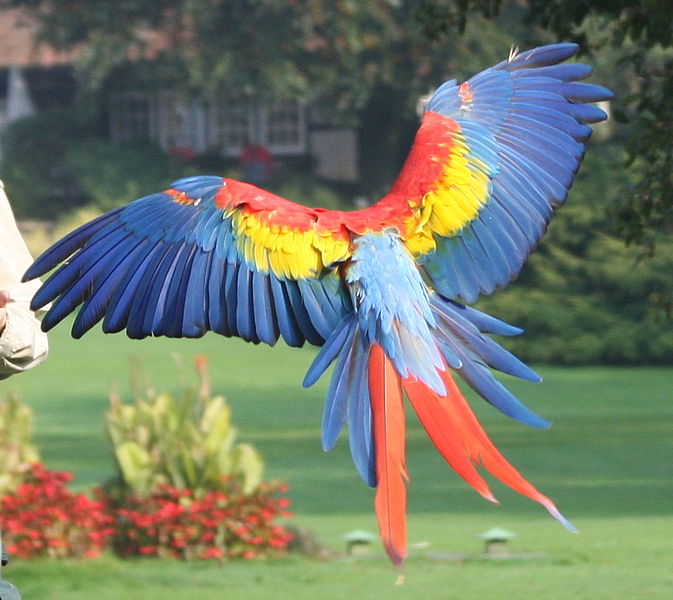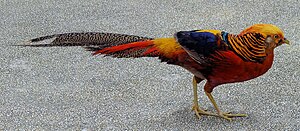Victoria Crowned Pigeon
The Victoria Crowned Pigeon (Goura victoria) is a large, bluish-grey pigeon with elegant blue lace-like crests, maroon breast and rediris. It is part of a genus of three unique very large, ground-dwelling pigeons native to the New Guinea region. The bird may be easily recognized by the unique white tips on its crests and by its deep 'whooping' sounds made while calling.[2] Its name commemorates theBritish monarch, Queen Victoria of the United Kingdom
Description
The Victoria Crowned Pigeon is a deep blue-gray color with a small black mask. Its feather crest (the signature feature of crowned pigeons other than their size) is conspicuously white-tipped. On the wing coverts, there is a row of feathers that are a paler blue-gray with maroon tips. These form a distinct wing bar. The chest is a deep purple-maroon color. As in all crowned pigeons, melanism has been observed. The other two crowned pigeons are somewhat superficially similar but only the Western Crowned Pigeon overlaps in range with the Victoria species. The Southern Crowned Pigeon does not. In the Westerns species, the crown is more scraggly and hair-like, the chest is a uniform blue-gray and not maroon and there is a less distinct wing-bar. Both sexes are similar.[3]
This species is typically 73 to 75 cm (29 to 30 in) long and weighs 2.38 kilograms (5.3 lbs). Some specimens may exceed a length of 80 cm (31 in) and a weight of 3.5 kg (7.7 lb).[4] It is marginally larger than the two other crowned pigeons on average and is thus considered the largest surviving species of pigeon of earth. The standard measurements among pigeons on mainland New Guinea are as follows: the wing chord is 36–39 cm (14–15 in), the tail is 27–30.1 cm (11–11.9 in), the bill is 3.2–3.5 cm (1.3–1.4 in) and the unfeatheredtarsus is 8.5–9.8 cm (3.3–3.9 in).[3]
Like other crowned pigeons, this species makes a loud clapping sound when it takes flight. The mating calls of this species are also similar to the other two species of crowned pigeon, consisting of a deep hoom-hoom-hoom-hoom-hoom sound. When defending their territories, these birds make a resounding whup-up, whup-up, whup-up call. Their contact call is a deep, muffled and rather human-likeummm or hmmm.[3]
There are two subspecies of the Victoria Crowned Pigeon, Goura victoria beccarii is found on the mainland of New Guinea. Goura victoria victoria, the nominate race can be found on the islands of Yapen, Biak and Supiori. The nominate subspecies is markedly smaller, with a wing chord measurement of 31.6–33.2 cm (12.4–13.1 in), with less robust legs and feet and darker overall plumage. The nominate has a sparser crest with black on the wing coverts and right above the tail.[3]
Habitat
Life history
Like other crowned pigeons, the Victoria Crowned Pigeon is a gregarious species. They usually travel in pairs or small parties as they search for food. They walk with an unhurried gait along the forest floor. Their prey typically consists of fallen fruit. Birds of this species in captivity are particularly found of eating figs. Seeds and invertebrates may occasionally supplement the diet. When disturbed, these birds flight straight up onto the canopy or a large horizontal branch of a large forest tree. After being distubred, they may remain still on their perch for a considerable time engaging in contact calls and flick their tail. In the wild, this species tends to be shier than the Western Crowned Pigeon, but can still occasionally be quietly approached.[3] The males regularly engage in aggressive displays in order to establish dominance. In these interactions, the pigeons puff up the chest and repeatedly raise their wings as if preparing to strike their opponent. They will also make short dashes at each other and may actually hit one another, but rarely make contact and can be completely peaceful towards other males outside of the early mating season.
Reproduction
Breeding peaks late in wet season and in the dry season. When the male displays for the female, he lowers his head down, stretches forward and then rhythmically swings his head up and down while simultaneously wagging his fanned tail. Although the female does most direct brooding, both parents help raise the young. The female usually lays a single white egg in a well-built tree nest of stems, sticks and palm leaves. In the weeks before she lays the egg, the male brings nesting material to the female. The egg is incubated for around 30 days. The young leave the nest when they are still much smaller than their parents but are actively tended to for a total of 13 weeks.
Status
The Victoria Crowned Pigeon is now the most rarely occurring of the three crowned pigeon species in the wild, although it is the most widely kept species in captivity. Perhaps the most pressing threat to the species is continuing habitat loss due to logging. It now quite uncommon near human habitations due to the fact that it is heavily hunted around them, particularly in areas where gun-possessing is prevalent. It can quite tame and easily shot, though now seems to be fearful of humans in the wild. Most hunting is for its plumes and meat. Trapping of pigeons to be kept alive for captive collections is now illegal but is still likely to be occurring. The Victoria Crowned Pigeon is evaluated as Vulnerable on the IUCN Red List of Threatened Species.[1] It is listed in Appendix II of CITES.







